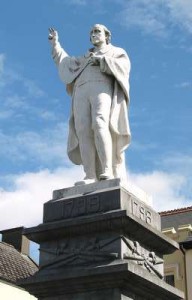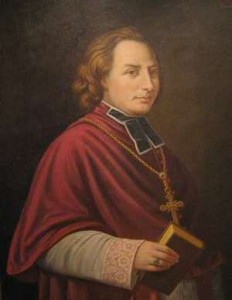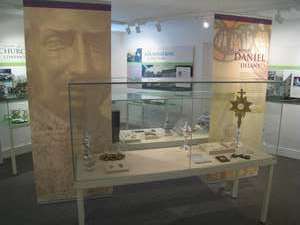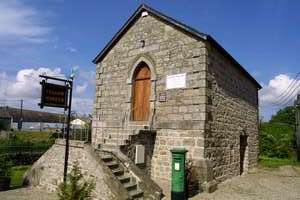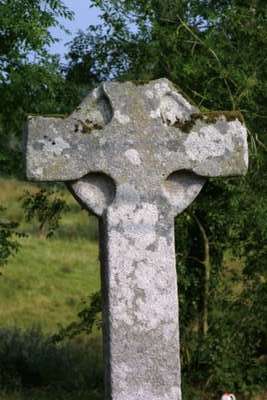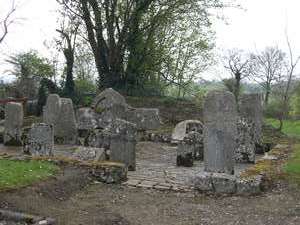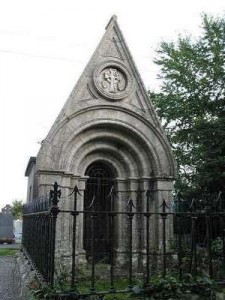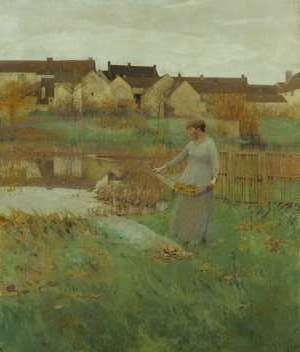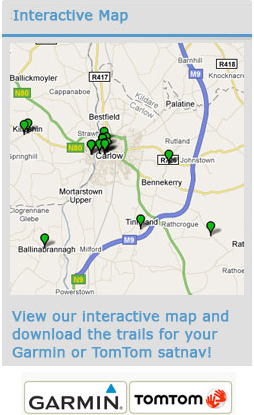Sites
Tullow – An Tulach – The Hill
With its picturesque location on the banks of the River Slaney, Tullow is a lovely example of a traditional Irish Town and is known locally as the granite town because of the fine stone used in its walls and public buildings. Tullow was a location of ecclesiastical importance from at least the late fifth century when a monastery was founded by St. Fortiarnán (Fortchern). No traces of this remain although the large granite cross base and font in the churchyard of the present St. Columba’s Church of Ireland parish church may have been associated with the early monastery.
An Augustinian Friary was founded in 1314 on the south side of the River Slaney. There are no remains apart from the head of a solid-wheeled cross with mouldings and projecting arms with decorative work and a holy well surmounted by a cross head within the graveyard.
Tullow’s enduring connection with ‘Brave Fr. Murphy’ of Boolavogue, Co. Wexford is commemorated by a fine statue in the town square. Described as the most wanted and notorious insurrection leader of the 1798 rebellion against British rule, Fr. Murphy was executed in Tullow.
He endured a public and humiliating death by hanging in the market square. According to the local Nationalist newspaper in 1905 when the monument was unveiled, “it is doubtful if throughout the whole of provincial Ireland such a large assembly of nationalists has been witnessed in recent years”. The famous song Boolavogue is dedicated to his memory.
Then, Fr. Murphy from old Kilcormack,
Spurred up the rocks with a warning cry;
‘Arm! Arm!’ he cried, ‘for I’ve come to lead you,
For Ireland’s freedom we’ll fight or die!’
Boolavogue by P.J. McCall
During the early years of the nineteenth century, Daniel Delany, Bishop of Kildare and Leighlin, saw education as a pathway to a fuller and better life for all. To progress his vision he founded the Brigidine Sisters in 1807 and the Patrician Brothers in 1808. He also founded the present Catholic Church of the Holy Rosary. The church was dedicated in 1805; the tower and steeple were added in 1833. The fine Bishop Daniel Delany Museum in the Brigidine Convent gives a history of these orders and displays artefacts associated with the bishop.
DID YOU KNOW
During the 1960s Cork born Patrician Brother Colm O’ Connell was educated at the Patrician Colleges of Mount Wolseley and Ballykealy. Since 1976 he has been based at their school in Iten, Kenya from where he has trained more international and Olympic athletes than any other school in the world.
 Open: Please phone the Brigidine Convent in advance of your visit. T: 059 9151308. Other sites daily, daylight hours.
Open: Please phone the Brigidine Convent in advance of your visit. T: 059 9151308. Other sites daily, daylight hours.
Admission: Free. Parking: Yes
TULLOW MUSEUM
Housed in an attractive, stone built, former Methodist church at the River Slaney Bridge. Tullow Museum features a splendid collection of artefacts reflecting local history, in particular Fr. Murphy’s connection with the town, including what are alleged to be his last vestments. The museum also features a collection of local photographs and information on burial grave stones. The museum welcomes any information or artefacts for display purposes especially photographs (on loan or for gift).
 Open: Until the end of October: Sundays and Bank Holidays 2 – 5 p.m. Tuesday, Wednesday, Thursday and Friday 2 – 4 p.m. Closed Monday and Saturday. Other times by appointment. T: 086-3416919 (during opening times), 087-2383515 (anytime).
Open: Until the end of October: Sundays and Bank Holidays 2 – 5 p.m. Tuesday, Wednesday, Thursday and Friday 2 – 4 p.m. Closed Monday and Saturday. Other times by appointment. T: 086-3416919 (during opening times), 087-2383515 (anytime).
Admission: Free, voluntary contributions welcome.
Parking: in the centre of the town.
St. Columba’s Church of Ireland church
St. Columba’s
Church of Ireland church
Clonmore – Cluain Mhór – Great Meadow
22.
Clonmore is one of Carlow’s most important early Christian sites with a wealth of history for visitors to discover. The present road cuts through the monastery founded by St. Maedóc around 600 A.D. No traces of the monastic buildings remain but the importance of the site is attested by the presence of two large crosses, nineteen cross-inscribed stones, an ogham![]() stone and two bullaun
stone and two bullaun![]() stones.
stones.
The monastery of Clonmore flourished from the seventh to the eleventh century and at least six saints were associated with it. As well as St. Maedóc (also called Mogue), these included St. Fionnán Lobhair and St. Oncho who is said to have been buried in the cemetery along with a substantial collection of relics. The monastery was an important pilgrimage site and it also attracted less welcome visitors in the form of Viking raiders who attacked the monastery on Christmas night 836.
In 1040, Clonmore was plundered by Diarmait Mac Máele-na-mbó, King of Uí Chennselaig, as part of his campaign to gain control of Leinster. Following the arrival of the Anglo-Normans in 1169, Clonmore became a manorial centre and an earthwork castle (motte) and stone castle were built here.
The monastic church may have become the medieval parish church and occupied the site of the present simple three-bay Church of Ireland church erected c.1812. The West Cross, also known as the Mission Cross and Mogue’s Cross, stands close to this church in the graveyard on the north side of the road. The shaft and head are composed of a single piece of granite standing over two meters high.
Across the road the shaft of another cross stands in the centre of the graveyard while the head can be found in the right hand corner, fixed into the ground along with a large collection of slabs and cross-inscribed stones. This cross head has a solid wheel on both faces, decorated with small wheeled crosses in medallions in relief at the centre of the wheel.
Clonmore houses a fascinating collection of crosses featuring exceptional examples of craftsmanship including one very unique piece. This unusual slab dated to the ninth or tenth century with a distinctive ‘tree of life’ motif is situated at the back, on the right. This can only be seen properly in certain lights and is made difficult by the presence on the stone of much later inscriptions. It is possible that the decoration may have been copied from a piece of continental metalwork and it is an indication that this inland monastery had far ranging contacts.
St. Mogue’s Well is now protected by an enclosure and surrounded by a pleasant garden area through which a stream runs. Look out for the fine tripled-holed bullaun ![]() stone nearby at the side of this stream.
stone nearby at the side of this stream.
DID YOU KNOW
In recent times a movement of people in South East Ireland have endeavoured to breathe life into an age-old tradition of socialising, music and fun. The “House of Song and Story” in Clonmore is an attempt to revive what was known in the past as ‘The Rambling House’ where people would gather of an evening to discuss local events, share stories and listen to music played by the gathered musicians. For details of upcoming events visit www.carlowtourism.com.
Admission: Free
Parking: At nearby pub in the village centre.
![]() Ogham stone: Stone bearing inscription in ancient Celtic alphabet comprising straight lines.
Ogham stone: Stone bearing inscription in ancient Celtic alphabet comprising straight lines.
![]() Bullaun stone: Stone with man-made circular depressions usually found near early church sites. Various functions have been suggested for these stones, some ritual and some associated with metal-working or grinding of corn.
Bullaun stone: Stone with man-made circular depressions usually found near early church sites. Various functions have been suggested for these stones, some ritual and some associated with metal-working or grinding of corn.
Bennekerry – Binn an Choire – Hill of the Sheep
23.
Frank O’Meara (1853-88), an internationally famous nineteenth-century impressionist artist is buried in St. Mary’s Catholic Church which dates from the 1860s. His tomb is designed after the medieval doorway at Killeshin.
Frank spent his early years in Dublin Street, Carlow where his father Dr. Thomas J. O’ Meara was medical officer and honorary professor of animal physiology and zoology at Carlow College. O’Meara studied at Carlow College before moving to Dublin to complete his education. In the early 1870s he moved to Paris to study art. He became associated with the Plein- Air or Open Air style of painting and is regarded as the most noted Irish painter in that style. The Hugh Lane Gallery on Parnell Square in Dublin carries a selection of his important works.
Frank O’ Meara returned to Carlow in the spring of 1888. He was suffering from malaria which he had had for approximately seven years. He died at the family home with his father present. He was only 35 years old. He was buried at the family graveyard in Bennekerry where his family erected this impressive tomb.
DID YOU KNOW
A brother, a sister and Frank’s mother died before he was 20 and these tragedies had a lasting effect on him. His paintings are beautiful but there is a sadness or loneliness involved which reflects this loss. Some refer to the atmosphere created by his paintings as a silent and dreamlike Celtic Twilight.
Admission: Free
Parking: Yes
